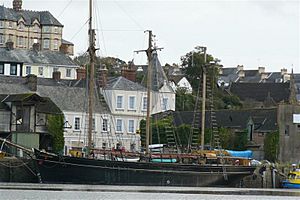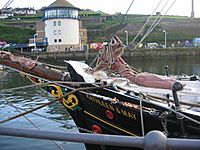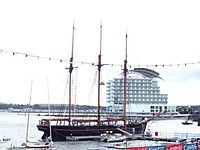Kathleen and May facts for kids

|
|
Quick facts for kids History |
|
|---|---|
| Name | Kathleen & May |
| Ordered | 1900 |
| Builder | Ferguson and Baird |
| Laid down | 1900 |
| In service | April 1900 |
| Out of service | 1961 |
| Reinstated | 1999 |
| Homeport |
|
| Identification |
|
| Status | Museum ship |
| General characteristics | |
| Class and type | Schooner |
| Tonnage | 136 GRT |
| Length | 98.4 ft (30.0 m) |
| Beam | 23.2 ft (7.07 m) |
| Speed | 17.15 knots (31.76 km/h) |
Kathleen and May is a very special ship! She's the last remaining British-built wooden three-masted top sail schooner. A schooner is a type of sailing ship with at least two masts, where the front-to-back sails are the main way it moves.
Even though she's registered in Bideford, North Devon, she is currently based in Liverpool. This amazing ship is officially listed as part of the National Historic Fleet, which means she's an important part of Britain's history on the water.
Contents
The History of the Kathleen and May
Building a New Ship in 1900
The Kathleen and May was built in 1900 by Ferguson and Baird. Their shipyard was located in Connah's Quay, Flintshire, for a local shipping company called Coppack Bros. The ship was made with a double frame of strong oak wood. These frames were then covered with thick, seasoned pitch pine planks. These planks were attached using wooden pegs called treenails and iron bolts.
The ship was also fitted with a new invention called Appledore roller reefing. This system made it easier to roll up the sails using a special lever. When she was launched in April 1900, Captain John Coppack named her Lizzie May after his daughters.
Working the Seas and a New Name
The Lizzie May started her life working in the Irish Sea. By 1908, she had sailed almost 40,000 miles! That year, she was sold to Martin J Fleming, who owned a fleet of ships that carried coal in Youghal, Ireland. He renamed her the Kathleen and May, also after his daughters.
Before World War I, Fleming made some changes to the ship. He added a longer lower yard to make the middle sail bigger. He also added a martingale to the bowsprit, which is a pole sticking out from the front of the ship. From then on, she mostly carried coal between Youghal and the ports in the Bristol Channel.
Life in Appledore and Engine Upgrades
In 1931, Captain Jewell from Appledore, North Devon, bought the ship. When she arrived in her new home port, she got a new 80 brake horsepower (60 kW) Beardmore diesel engine. Her topmasts were also made shorter because her topsails were removed.
The Kathleen and May survived big storms in February 1936. In 1937, she had engine trouble near Youghal's lighthouse but managed to reach the port safely. In 1943, her engine was upgraded again to a more powerful 125 brake horsepower (93 kW) Deutz diesel engine.
After Captain Jewell passed away in 1945, his son Tommy took over the ship. In 1947, he removed the martingale. The ship continued to carry coal in the Irish Sea, but this trade was slowly disappearing.
Bringing the Kathleen and May Back to Life

In the early 1960s, a film company bought the ship. She was used in a few movies and then stored in Southampton Water. In 1966, a master mariner named Captain WP (Paul) Davis saw her there. He loved old ships and sold most of his collection of vintage cars to buy her.
With the help of just one friend, McKenzie (Ken) Morgan, Paul sailed the ship to Appledore. He worked on restoring the schooner for five years, selling more of his old cars to pay for it. Paul dreamed of making her a working merchant ship again, but the job was too big. In 1970, he sold her to the Maritime Museum.
The Maritime Trust and Steve Clarke's Vision
The Duke of Edinburgh created the Maritime Trust in London to help save important British ships. The Trust moved the Kathleen and May to Gloucester Docks and started restoring her. However, they couldn't get a large grant from the National Lottery Heritage Fund.
Then, a businessman named Steve Clarke from Bideford, Devon, bought her. In February 1999, she was towed to Bideford. Two huge cranes lifted her out of the water and placed her on the old Brunswick Wharf. About 70% of her original outer planks were removed so that her inner wooden parts could be repaired.
The back of the ship was taken apart down to its lowest timbers. The front of the ship needed 6.5 tons of new oak wood to be replaced. Once the frames were put back together, the old parts were cleaned with high-pressure steam to kill any fungal spores.
Modern Upgrades and Recognition
The ship was given a 400 brake horsepower (300 kW) Detroit diesel engine, which came from an old lifeboat. Instead of one propeller, she now has two propellers that are powered by hydraulics. This means she can travel 2,000 miles using only her engine!
Her deck was replaced with new, seasoned wood. All her masts and rigging were restored to look exactly as they did when she was first built in 1900. After all this work, she passed a strict safety inspection.
Because of his amazing efforts in restoring the Kathleen and May, Councillor Steve Clarke was given the OBE award in 2008.
The Kathleen and May Today

Since her restoration, the Kathleen & May has been based in Bideford on the River Torridge. She regularly sails across the Bristol Channel and the Irish Sea. She has even returned to Youghal, where she once carried coal.
The ship has also attended many festivals and sailed across the Bay of Biscay to Bilbao. There, she was a special guest at the Guggenheim museum.
Since 2010, the Kathleen & May has been docked in Albert Dock next to the Merseyside Maritime Museum. She continues to be a proud reminder of Britain's sailing past.

